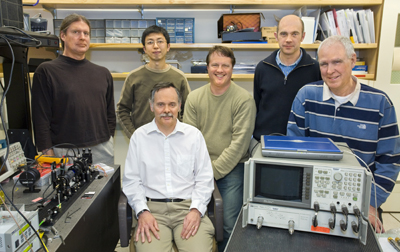Timing at the Speed of Light
|
|
|
|
 |
 |
|
|
From left, Russell Wilcox, Gang Huang, Larry Doolittle (seated), John Byrd, Alex Ratti, and John Staples |
|
|
|
How can you be sure that two events a couple of kilometers apart happen simultaneously -- or at least within a few quadrillionths of a second of each other? It's the sort of problem that increasingly faces builders and users of accelerators and free-electron lasers, where machine components separated by many kilometers may have to be synchronized precisely, or where a "pump-probe" experiment may depend on the timing between a laser pulse at the experiment and a separate pulse originating in the accelerator half a kilometer away.
Contemplating synchronicity is what led the young Einstein to the special theory of relativity, which answers the question, "How you can be sure two distant events happen simultaneously?" The answer is, "You can't"; simultaneity is never absolute but arises from the relative position and velocity of the observers and the finite time needed to communicate among them. Einstein concluded that the speed of light (in vacuum) is the speed limit of the universe, implying that the closest one can come to synchronization is to exchange light signals. For modern accelerators using today's modern optical communications technology, this is now possible.
John Staples, a physicist in Berkeley Lab's Accelerator and Fusion Research Division (AFRD), working with Russell Wilcox of the Engineering Division, came up with a way to make a practical light-clock several kilometers long. They sent laser light, maintained at a specific frequency, through a two-kilometer length of optical fiber, then reflected the light back on itself. In this way the light waves were made to interfere with one another and produce interference fringes, which could easily be counted.
There's a catch: any change in the length of the fiber will change the number of fringes per unit length. Lots of things change the length of a kilometers-long optical fiber, including temperature changes from day to night and even loud noises, which are not rare in big accelerator tunnels.
"So we monitor the number of fringes and add or subtract length to maintain the right number," Staples says. In other words, they continually stretch or shrink the optical path so that it always contains the same number of light waves.
They do this by wrapping some of the fiber around a piezoelectric crystal that, when a phase shift is detected, responds quickly to changes in an electric field and expands or contracts to lengthen or shorten the optical path -- if only slightly. Bigger adjustments take longer and are achieved by gradually moving a mirror, which reflects the laser beam emitted from one section of fiber and sends it on to the other.
Initial tests using fiber-optics communications cables running through buildings and under busy roads at Berkeley Lab were so promising that the Berkeley Lab researchers approached the builders of the Linac Coherent Light Source (LCLS) at the Stanford Linear Accelerator Center, which will be the world's first hard-x-ray free electron laser (FEL) when it achieves first light in 2009.
The Berkeley Lab optical synchronization system was tested at the LCLS site by stringing an optical fiber two kilometers down the tunnel of the linear accelerator and back. A reference laser beam was sent through the system continuously for a month, its stability maintained by automatic compensating mechanisms that kept the length of the optical path constant to within less than a wavelength. During the entire month the accuracy of the laser clock never varied more than 15 femtoseconds (15 quadrillionth of a second). In August 2007, SLAC awarded a three-year, $2.2 million contract to Berkeley Lab to build a high-precision timing system based on this principle, for synchronizing many of the LCLS laser systems with the lasers used at the experimental end stations.
"Our system will be the master clock for the LCLS lasers and, we hope, eventually for the rest of the accelerator," says John Byrd of AFRD, the project leader. "Their specifications call for us to maintain an accuracy of 100 femtoseconds, but we've already done better than that in tests, and what the LCLS really wants from us is perfect accuracy. We'll try to get as close as we can."
The timing and synchronization system Berkeley Lab is providing is the Lab's only participation in LCLS, a major step forward in free-electron laser technology. But the Lab is also working with other major accelerator centers around the world, and not least on its own plans for a revolutionary light source and free-electron laser facility, the Advanced Photon Initiative.
For more about the fiber-optic timing and synchronization system visit http://www.lbl.gov/Science-Articles/Archive/sabl/2007/Jun/nSync.html
|

